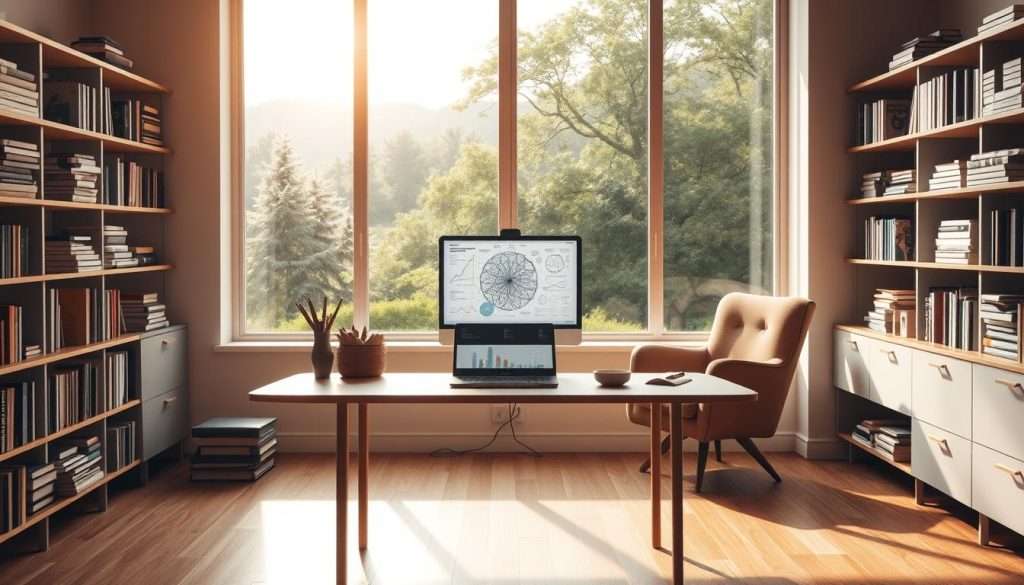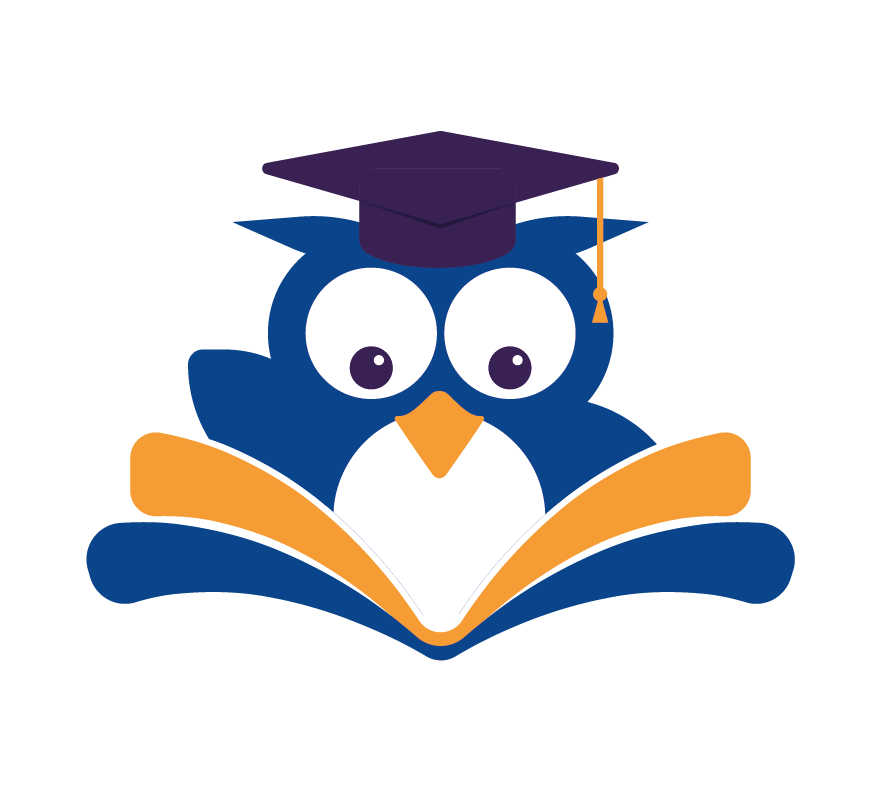In today’s fast world, learning strategies are more important than ever. The Industrial Revolution changed how we work, moving from manual labor to tasks based on knowledge. Now, we must always learn new skills to stay ahead.
To really thrive, we need to know how to make our brains work best for knowledge tasks. This means being careful about how we learn and using good strategies to use our time and energy well.
By mastering the art of learning, we can reach our full potential and meet our goals. It’s about being proactive and taking control of our learning journey.
Key Takeaways
- Adapting learning strategies is crucial in today’s fast-paced world.
- Understanding how to optimize our brains for knowledge work is key.
- Being intentional about learning is vital for success.
- Effective learning strategies can significantly impact our productivity.
- Mastering the art of learning unlocks our full potential.
The Science Behind Effective Learning
Learning how our brains work can change how we study. Mithu Storoni, a Cambridge-trained doctor and neuroscience expert, says our brain is like an engine. Knowing how to switch gears can improve our learning.
How Your Brain Processes New Information
When we learn something new, our brain handles it in different ways. First, it goes to the hippocampus, key for making new memories. Then, it moves to long-term memory through a process called synaptic plasticity. To get the most out of this, we need to actively recall what we’ve learned.
The Neuroplasticity Advantage
Neuroplasticity means our brain can make new connections at any age. This idea shows our brain isn’t fixed after a certain time. By trying new things and learning new skills, we can make our brain more adaptable.
Learning Styles: Myth vs. Reality
The idea that we’re visual, auditory, or kinesthetic learners has been around. But, research shows it might not be true. Instead, using a mix of methods can help us learn better by engaging different senses.
Assess Your Current Learning Capabilities
Before you can get better at learning, you need to know where you are now. It’s important to understand your strengths and weaknesses. This helps you see what you need to work on.
Identifying Your Strengths and Weaknesses
To get better at learning, know what you’re good at and what you’re not. Think about your past learning experiences. What subjects come easily to you? Which ones are hard?
Knowing your strengths and weaknesses helps you learn better. You can focus on areas you need to improve.
Conducting a Personal Learning Audit
A personal learning audit is like checking your learning tools. Josh Waitzkin, a learning expert, says it’s key to learn on your own. Ask yourself: What do I want to learn? What has worked for me before? What holds me back?
By answering these questions, you can find what to improve and how to do it. This helps you learn better.
Setting Your Learning Baseline
Setting a learning baseline is vital to track your progress. It’s like setting a goal for your learning. By setting a baseline, you can see how much you’ve improved. This helps you adjust your learning plan as needed.
So, start today! Check your learning skills, find your strengths and weaknesses, and set a learning goal. With this, you’ll be on your way to becoming a better learner.
Creating Your Optimal Learning Environment
Your surroundings greatly affect how well you learn. Let’s make them perfect. Andrew Huberman, a neurobiology professor, says an optimal learning environment is key.
Physical Space Optimization
Give your study area a makeover. Clear the clutter and ensure good lighting. A clean space helps clear your mind, making learning easier.
Digital Environment Management
Your digital world can be distracting too. Turn off notifications or use “do not disturb” mode. Tools can help you stay focused and use educational resources better.
Eliminating Distractions and Triggers
Find out what distracts you most and get rid of it. It could be social media, email, or family chatter. Plan to reduce interruptions. This way, you’ll learn faster and reach your goals sooner.
Optimizing your space, managing your digital world, and cutting distractions will help you create a great learning environment. This environment will support your success.
Core Strategies to Master the Art of Learning
Learning isn’t just about knowing stuff. It’s about learning how to use that knowledge. As you start your personalized learning journey, it’s key to use learning strategies that fit you.
Now, let’s explore some main strategies for learning well. These methods boost how well you remember, understand, and use new info.
The Pomodoro Technique for Focused Study
The Pomodoro Technique is a great way to stay focused. You work in 25-minute chunks, then take a 5-minute break. After four of these, take a 15-30 minute break. It keeps you on track and prevents burnout.
Spaced Repetition Systems
Spaced repetition helps you remember things for a long time. It means reviewing material at longer and longer intervals. This way, you can make your study sessions more effective and keep more info in your memory.
Active Recall: The Testing Effect
Active recall means trying to remember info instead of just reading it again. It’s a very effective way to keep info in your memory and understand it better. Try using flashcards or quizzes to make active recall part of your study routine.
Deliberate Practice Principles
Deliberate practice means focusing on specific skills or subjects you want to get better at. It needs concentration, feedback, and being willing to try harder than you’re comfortable with. By using deliberate practice, you can learn faster and reach your goals sooner.
By using these main strategies in your personalized learning journey, you’ll be well on your way to mastering learning. You’ll reach your goals in no time.
Memory Enhancement Techniques
Unlocking your memory’s full potential can change your learning journey. The right techniques can improve how well you remember and recall information. This makes your study sessions more effective.
The Memory Palace Method
The Memory Palace technique, also known as the method of loci, is ancient. It involves visualizing a familiar place and linking the information you want to remember to specific spots. This method uses your brain’s ability to remember spatial information.
To use this method, picture a place you know well, like your home. Then, link the items you want to remember to specific spots in that space. For example, imagine each item on a list at a different spot in your home.
Chunking Information Effectively
Chunking breaks down information into smaller, easier-to-remember chunks. This helps with remembering complex information, like phone numbers or lists.
For example, when trying to remember a long number, break it down into smaller groups. Like a phone number: 123-456-7890.
Association and Visualization Strategies
Association links new information to something you already know or find meaningful. Visualization creates mental images to represent information. Both can greatly improve memory.
Try to create vivid mental images that connect with the information you’re trying to remember. The more unusual the image, the better it will stick in your memory.
Mnemonic Devices That Actually Work
Mnemonic devices help remember information through associations. Examples include acronyms, rhymes, and mind maps.
- Acronyms: Create an acronym from the first letters of the items you’re trying to remember.
- Rhymes: Use rhyming words to make information more memorable.
- Mind Maps: Visualize information in a map format, using colors and images to make it more engaging.
By using these memory enhancement techniques in your study routine, you can improve your effective study habits and achieve cognitive enhancement. Try different methods to see what works best for you.
Overcoming Learning Plateaus and Obstacles
Starting your learning journey can be tough, but you can get past obstacles. Learning is a journey with ups and downs. It’s normal to hit a plateau or face challenges.
Dealing with Procrastination
Procrastination is a big hurdle for many learners. To beat it, we need to know why we do it and find ways to stop. Breaking down big tasks into smaller ones makes them easier to handle.
- Set clear, achievable goals for each study session.
- Use the Pomodoro Technique to work in focused intervals.
- Eliminate distractions by creating a conducive learning environment.
Managing Information Overload
Handling too much information is key to learning well, as Mithu Storoni points out. With so much info out there, it’s easy to feel overwhelmed. We need to learn to filter out what’s not important and focus on what is.
“The key to managing information overload is not to avoid it, but to learn how to navigate it effectively.” – Mithu Storoni
Here are some ways to deal with too much information:
| Strategy | Description |
|---|---|
| Prioritization | Focus on the most critical information first. |
| Filtering | Use tools and techniques to filter out irrelevant information. |
| Organization | Organize information in a structured and accessible manner. |
Techniques for Pushing Through Difficult Concepts
Running into tough concepts is part of learning. To get past these challenges, try these techniques:
- Active recall: Test yourself on the material you’re trying to learn.
- Spaced repetition: Review material at increasingly longer intervals.
- Deliberate practice: Focus on practicing the skills you’re trying to develop.
Recovering from Learning Burnout
Learning burnout is feeling emotionally, mentally, and physically drained. It happens from too much stress, overwork, and not balancing life. To get better, take breaks, take care of yourself, and check if your learning goals still match your interests.

By using these strategies, you can beat common learning obstacles and keep moving forward. Remember, the real success in learning isn’t just about knowing more. It’s also about keeping a healthy and positive attitude towards learning.
Technology and Tools for Accelerated Learning
The right technology can make learning faster and more effective. There are many digital tools out there. You can customize your learning to fit your needs.
Digital Flashcard Systems
Digital flashcard systems like Anki and Quizlet change how we learn. They use spaced repetition to help you remember better.
Note-Taking Applications and Methods
Good note-taking is key to learning. Apps like Evernote and OneNote help you organize your thoughts. They make reviewing material easy.
AI-Powered Learning Assistants
AI-powered learning assistants are getting popular. Tools like Duolingo adapt to your learning pace and style. They make learning personal.
Knowledge Management Systems
A good knowledge management system helps organize your learning. Tools like Notion or Trello create a central place for your learning. It makes reviewing and connecting new info easier.
As “The future of learning is not just about accumulating knowledge, but about being able to access and apply it effectively.” Using these technologies can greatly improve your learning. It makes learning more efficient and fun.
Building Your Personalized Learning System
Your learning journey is as unique as your fingerprint. Building a personalized system is key to unlocking your full potential. You need a tailored approach that fits your learning style, goals, and lifestyle.
Creating Learning Rituals and Habits
Creating consistent learning rituals and habits is crucial. Josh Waitzkin says a routine helps develop a growth mindset. For example, learning at the same time each day, like early morning or before bed, keeps you on track.
To make learning a habit, start small. Begin with short sessions, like 20 minutes a day. Gradually increase the time as you get more comfortable. Sticking to a daily routine is better than cramming all learning into one or two long sessions.
Designing Your Learning Curriculum
Designing a learning curriculum that aligns with your goals is key. Identify what you want to achieve and break it down into smaller, manageable chunks. This keeps you focused and motivated.
Think about what topics you need to cover and in what order. Explore different resources like textbooks, online courses, or workshops. This keeps your learning diverse and engaging.
Tracking Progress and Adjusting Methods
Tracking your progress is essential. It helps you see what’s working and what needs improvement. Keep a learning journal or use a tracking app to monitor your progress.
Integrating Learning Into Your Lifestyle
Integrating learning into your daily lifestyle makes it sustainable. Look for opportunities to learn during your commute, while exercising, or during work breaks. For example, listening to podcasts or audiobooks is a great way to use idle time.
By making learning a part of your daily routine, it becomes more enjoyable. Remember, the goal is to make learning a sustainable part of your life, not an additional stress.

Conclusion: Your Journey to Learning Mastery
As we conclude our look into mastering learning, it’s clear this path is both tough and rewarding. By using the strategies and techniques from this article, you’re starting to reach your learning goals. You’re unlocking your full potential.
To truly master learning, you must be consistent, persistent, and patient. We’ve covered ways to improve your learning space, boost your memory, and get past hurdles. Now, it’s your turn to apply these tips and make learning fun and effective.
Keep moving forward on your learning path. Every step shows your dedication and effort. Stay motivated, curious, and watch yourself grow. You’re not just learning – you’re changing your life.

